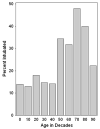Endotracheal Intubation in Patients Treated for Prehospital Status Epilepticus
- PMID: 25623785
- PMCID: PMC4516705
- DOI: 10.1007/s12028-014-0106-5
Endotracheal Intubation in Patients Treated for Prehospital Status Epilepticus
Abstract
Introduction: Limited data describe the frequency, timing, or indications for endotracheal intubation (ETI) in patients with status epilepticus. A better understanding of the characteristics of patients with status epilepticus requiring airway interventions could inform clinical care. We sought to characterize ETI use in patients with prehospital status epilepticus.
Methods: This study was a secondary analysis of the Rapid Anticonvulsant Medication Prior to Arrival Trial, a multi-center, randomized trial comparing intravenous lorazepam to intramuscular midazolam for prehospital status epilepticus treatment. Subjects received ETI in the prehospital, Emergency Department (ED), or inpatient setting at the discretion of caregivers.
Results: Of 1023 enrollments, 218 (21 %) received ETI. 204 (93.6 %) of the ETIs were performed in the hospital and 14 (6.4 %) in the prehospital setting. Intubated patients were older (52 vs 41 years, p < 0.001), and men underwent ETI more than women (26 vs 21 %, p = 0.047). Patients with ongoing seizures on ED arrival had a higher rate of ETI (32 vs 16 %, p < 0.001), as did those who received rescue anti-seizure medication (29 vs 20 %, p = 0.004). Mortality was higher for intubated patients (7 vs 0.4 %, p < 0.001). Most ETI (n = 133, 62 %) occurred early (prior to or within 30 min after ED arrival), and late ETI was associated with higher mortality (14 vs 3 %, p = 0.002) than early ETI.
Conclusions: ETI is common in patients with status epilepticus, particularly among the elderly or those with refractory seizures. Any ETI and late ETI are both associated with higher mortality.
Conflict of interest statement
Figures




References
-
- Alldredge BK, Gelb AM, Isaacs SM, et al. A comparison of lorazepam, diazepam, and placebo for the treatment of out-of-hospital status epilepticus. N Engl J Med. 2001;345:631–7. - PubMed
-
- DeLorenzo RJ, Hauser WA, Towne AR, et al. A prospective, population-based epidemiologic study of status epilepticus in Richmond, Virginia. Neurology. 1996;46:1029–35. - PubMed
-
- Varelas PN, Mirski MA. Status epilepticus. Curr Neurol Neurosci Rep. 2009;9:469–76. - PubMed
-
- Brophy GM, Bell R, Claassen J, et al. Guidelines for the evaluation and management of status epilepticus. Neurocrit Care. 2012;17:3–23. - PubMed
-
- Meldrum BS, Brierley JB. Prolonged epileptic seizures in primates. Ischemic cell change and its relation to ictal physiological events. Arch Neurol. 1973;28:10–7. - PubMed
Publication types
MeSH terms
Grants and funding
LinkOut - more resources
Full Text Sources
Other Literature Sources
Medical

